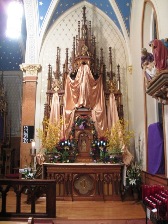 From a reader:
From a reader:
Is there any guidance about where the Altar of Repose on Holy Thursday should be located? For many years at my parish, it was located at one of the side altars in the Church (we have five to choose from). Our current pastor has experimented with its placement over the last three years; last year it was set up in the Church basement on a temporary altar, which is a space normally used for parish activities such as meetings and the Sunday morning coffee hour. Many parishioners are not happy about trekking out of the main Church and down to the hall. The pastor plans to use the same place this year, saying that under the rubrics the Altar of Repose is not supposed to be located at a side altar, which is still part of the main sanctuary. Is this correct? Many of us would like to revert to its prior placement but are unsure what the “rules” provide.
In… the … basement…
That sounds silly to me. But I am unreconstructed ossified manualist.
I think the Lord should be reposed on a side altar. I believe that practice is well attested in our Latin tradition.
But… documents. I don’t know at this moment, so I will open this to the readers, trusting that they will perhaps stay on topic.


































This is all I could find:
CDWDS, Dec 2001:
Holy Thursday
Visiting the Altar of Repose
141. Popular piety is particularly sensitive to the adoration of the Most Blessed Sacrament in the wake of the Mass of the Lord’s supper(145). Because of a long historical process, whose origins are not entirely clear, the place of repose has traditionally been referred to as a “a holy sepulchre”. The faithful go there to venerate Jesus who was placed in a tomb following the crucifixion and in which he remained for some forty hours.
It is necessary to instruct the faithful on the meaning of the reposition: it is an austere solemn conservation of the Body of Christ for the community of the faithful which takes part in the liturgy of Good Friday and for the viaticum of the infirmed(146). It is an invitation to silent and prolonged adoration of the wondrous sacrament instituted by Jesus on this day.
In reference to the altar of repose, therefore, the term “sepulchre” should be avoided, and its decoration should not have any suggestion of a tomb. The tabernacle on this altar should not be in the form of a tomb or funerary urn. The Blessed Sacrament should be conserved in a closed tabernacle and should not be exposed in a monstrance(147).
After mid-night on Holy Thursday, the adoration should conclude without solemnity, since the day of the Lord’s Passion has already begun(148).
Source: http://www.usccb.org/liturgy/holyweek.shtml
You attend a church with five side-altars? That is awesome! What a blessing it is to be your parish priest, and the mighty gift God has given him to offer the Most Holy Sacrifice on five side-altars.
Our Altar of Repose is in the basement, one would be hard pressed to recognize it though! We spend many hours transforming it into a ‘cave’ with hundreds of flowers and candles along with a waterfall and an altar. It is quite beautiful and an awesome place to sit with our Lord in prayer after Mass until midnight!
Surely the altar of repose should be set up at, er, an altar.
Bp. Elliott, in his book on ceremonies of the liturgical year, says that the procession is meant to represent the journey from the Cenacle to Gethsemane, and that it is thus preferable to have the altar of repose apart from the place where the Mass is offered.
I agree with Chonak about the procession and movement, and as homeschoolofthree pointed out, if decorated well and tastefully, one could transform a blah or mundane space into something worthy.
But no simple altar cloth over a card table! Put some effort into it!
The General Decree of the Sacred Congregation for Rites “To Restore the Liturgical Order of Holy Week” in 1955 – had this to say about the place of reposition:
Fr McManus’ 1956 Commentary on the Liturgies of Holy Week says that the place of reposition need not be an altar, and under no circumstances should be the High Altar. The decoration spoken of is to be decent but austere. No relics pictures or statues are allowed.
I don’t think waterfalls are entirely consistent with the severity traditionally required by the Church.
The CDWDS December 2001 document appears to be consistent with the SCR 1955 Decree.
And the 1962 MR says:
The document “Paschalis Sollemnitatis” (CDW, 1988), states:
While it doesn’t mention a side-altar specifically, the really interesting thing seems to be the endnote…from a certain document in 1955!:
Since this section of the 1955 decree is referenced as an endnote in “Paschalis” by the CDW, does that mean it still has force of law? Was someone in 1988 already thinking “hermeneutic of continuity?”
Maybe it would be good to recall the example we saw in a video from France where servers at an FSSP mass transformed a very plain modern altar to a trompe-l’oeil traditional one in under 15 minutes of time-lapse activity.
My old Missal from the late 1960’s, referring to the Stripping of the Altars, which used to be an
actual ceremony at the end of the Holy Thursday Mass and Procession, states “The Celebrant and
his ministers strip all the altars of the Church, except the one where the Blessed Sacrament is
solemnly adored.
By the way, is there some rule that Holy Thursday adoration must end at 10 p.m.? I know there
is not supposed to be any solemn adoration after midnight, but must we hide the Lord in the sacristy vault?